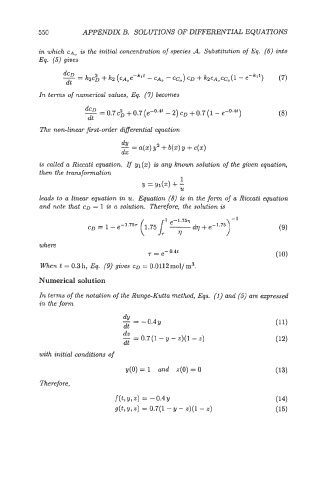Page 570 - Modelling in Transport Phenomena A Conceptual Approach
P. 570
550 APPENDIX B. SOLUTIONS OF DIFFERENTIlLL EQUATIONS
in which CA, is the initial concentration of species A. Substitution of Eq. (6) into
Eq. (5) gives
dCD
- k2cg + k2 (cAoe (7)
-'lt - cA, - cC,) CD + IC~CA,CC,(I - e-'")
=
dt
In terms of numerical values, Eq. (7) becomes
The non- linear first-order diflerential equation
dY
- = 4.) y2 + b(s) y + .(.)
dx
is called a Riccati equation. If yl(x) is any known solution of the given equation,
then the transformation
1
Y = Yl(4 + -
U
leads to a linear equation in u. Equation (8) is in the fom of a Riccati equation
and note that CD = 1 is a solution. Therefore, the solution is
where
,- = ,-0.4t
When t = 0.3 h, Eq. (9) gives CD = 0.0112 mol/ m3.
Numerical solution
In tern of the notation of the Runge-Kutta method, Eqs. (1) and (5) are expressed
in the form
-- - -0.4~
dy
dt
da
_- - 0.7 (1 - y - ~)(1- a)
dt (12)
with initial conditions of
y(0) = 1 and z(0) =O
There fore,

